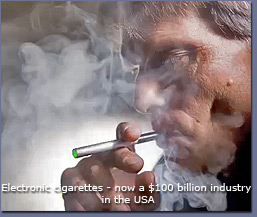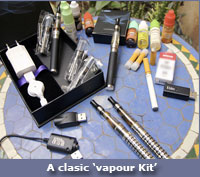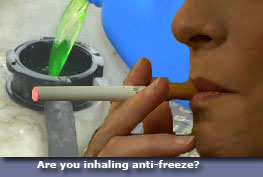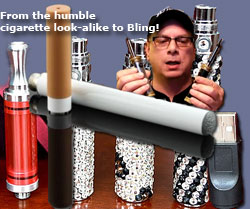 |
 |
|
Originally published in November 2013, this article has now been updated August 2014 In a mirror image of the beginning of cigarette and nicotine addiction, a whole new industry is developing which will save and preserve the international tobacco companies; using the same arguments – nicotine is harmless and as a smoker; E-Cigarettes are even a healthy choice.
In fact they even hid, in their adverts, that the product contains nicotine and highlights only the various choices in taste of the products. The Advertising Standards Authority adjudications upheld a number of complaints against individual brands, which include Sky Cigs, 5 Colors, Ten Motives and E-Lites because they were misleading and encouraged viewers to access their websites without any knowledge that the products contained nicotine. A TV ad for 5 Colors e-cigarettes stated, "Five Colors. What’s your flavour?" and showed adults jumping in the air, while fruits including strawberries and apples exploded in the background. On-screen text included a URL and telephone number. A perfect example of the type of misleading advertising that tobacco companies utilised for many many years until the danger of their product was finally rumbled, and the ban on advertising cigarettes on TV took hold. Currently electronic cigarettes and ‘vapour kits’ – so called because of the mixture of water vapour, nicotine and other chemicals that are given off in a cloud simulating the smoke of cigarettes – can currently legally be sold to anyone of any age, i.e. including children. There is no law preventing sales of e -cigarettes to under 18s at all! In fact two of the banned ads for E-cigarettes actually included scenes with families and children, making the link between normal family activities and smoking e-cigarettes. In advertising campaign on TV now in its early days, it is clear that the tool being deployed in these ads is once again – sex.
The 20-second TV ad featured in the Granada viewing area last night, shows a woman telling the viewer, "I want you to get it out, I want to see it, I want to feel it, hold it, put it in my mouth, I want to see how great it tastes", as the camera zooms in on her mouth and eyes. The two minute long website 'viral ads' are even more lurid, even crude. Further, the advert is clearly aimed at males, despite the fact that smoking is increasing amongst females and actually going down amongst males. Indeed nearly 100% of the advertising on the various company websites and on the various social networking sites is aimed at males, with information videos again featuring nearly 100% men. Absolutely no mention of the claimed health benefits associated with e-cigarettes is actually mentioned in the advert. But David Levin, co-founder of VIP is unapologetic about the 'controversy' of the ads but says the company takes their responsibility very seriously and markets the product only to adults over 18. However, the Advertising Standards Authority have received numerous complaints about the style and content of the advertising this company are putting out, and are investigating. Indeed since writing this original news item, the ASA have confiurmed that they have upheld such complaints. Vapour kits, as the new fad is called, rather than e-cigarette kits, are controversial because the technology has not been cleared totally of any health risks and because the kits are being marketed in a way to suggest that the basic electronic cigarette does nit deliver enough nicotine and that these new kits will enable a ‘bigger and quicker hit’ of nicotine. Indeed a whole new techie style language is being used to push the 'vaping' fad in an attempt to make it trendy and above the common and declining habit of 'smoking'. Far from now being held up as a healthy alternative to smoking standard tobacco based cigarettes, these kits are being marketed as a glamorous hobby and harmless pastime aimed at the tech savvy male.
They also provide at discounted prices, kits and models of electronic cigarettes in the form of tanks, and imported E-Liquid (Liquid nicotine) from China and produce their own brand of e-cig called called the Halo, all of which deliver a far greater amount of nicotine. Self filling and liquid nicotine is also available, with China being the biggest source of liquid nicotine. According to their website, and hidden away amongst the FAQ section, the company claims that these these products, including the liquid nicotine has been properly tested for chemical content and safety of use, and for efficacy of nicotine delivery and the effects on the user’s health. But whilst such claims are made, there has not been enough peer reviewed research to give e-cigs a clear bill of health. However, there are many suppliers with no regulated control over the efficacy and amount of nicotine in each vial of so-called ‘e-liquid’, the strength of the nicotine levels of each manufacturer’s version of electronic cigarette varies and cannot be guaranteed from one purchase or manufacturer to another. Many of the products actually advise how much nicotine is delivered to the user, but simply provide the quantity of e-liquid, as nicotine in liquid form is referred to. Many commentators now argue that the vapour in the product contains harmful chemicals and have never been tested and doubt the efficacy of the product in helping people quit smoking. In fact, they argue, people are simply swapping one addiction for another. Whilst some manufacturers use vegetable glycol, both that and Propylene Glycol are not entirely safe for use, despite PG being present in many beauty and skin care products. As with many chemicals in consumer products, one day they are considered safe, and the next research shows the same chemicals to be not safe at all. The argument over PG continues, and in any case, the ingestion or absorption into the human body of additional and unwanted chemicals could pose a health risk in itself. Indeed, one GP proponent of supplying e-cigs to smokers as an aid to quit smoking admits that the exhaled mist contains 1% nicotine; which means second-hand 'vapour' from the product can be inhaled by those nearest to the user of such products. Far from the claim by the electronic cigarette industry that no one but the user is effected by the product, tests have shown this to be untrue. These chemicals plus 1% nicotine are given off in the vapour due to the heating of the liquid nicotine and propellants. This in turn, can then be breathed in by anyone adjacent to the electronic cigarette user, as well of course by the person using these products. This is one reason why the TUC are against any use of electronic cigarettes in the workplace or so-called ‘smoking rooms’. But these products are not just being aimed at existing smokers, but also at a wider audience, including children! Just as the alcohol industry introduced flavoured ‘alco-pops’ aimed at a much larger audience than adults, despite their protestation to the contrary, the electronic cigarette industry is busy providing numerous flavourings to the liquid nicotine contained within their products. Flavours such as champagne, strawberry, caramel, menthol, cherry, vanilla, and chocolate are widely available – over the counter to anyone as well as via websites. Irrespective of ECITA members of the e-cig industry claiming that their products are not aimed at those under 18 years of age, the fact is that recent research shows that those under 18 are in fact obtaining the products. An investigation in July of this year by ITN, showed that even big supermarkets have sold e-cigarettes to under 18 yr olds. According to an ITN news item on 16th July 2014: "Findings for ITV News today shows just how easy it is for youngsters to get e-cigarettes. A third of outlets we tested made an underage sale during our research. Even big chains and supermarkets sold to an under 18-year-old - no questions asked." It also reports that the government is conisdering whether or not new laws specific to e-cigarettes need to be put in place. Far from simply being a claimed safer alternative to tobacco smoking, the selling of promotion material and T-shirts emblazoned with ‘I’m Vaping’ and ‘Smoker’s Angel’ is testimony to a new and lucrative industry using known and unproven health benefits, in the same way as tobacco companies still do in third world countries; as a way of maximising uptake, and addiction to nicotine, giving assured multi-million pound profits from current and future generations to come. It must also be recognised that e-cigarette use by pregnant women will not stop the foetus from ingesting the nicotine, and ultimately becoming addicted too. It also passes into breast milk and from there to the baby and in the saliva of the woman.
In effect users of e-cigarettes are inhaling into their lungs a product which is entirely unproven with regard to its overall health benefits or controlled to ensure it poses no harm to human health of both long-term use and the exposure to and inhalation of the vapour by people within the immediate vicinity of e-smokers. Whilst there is undoubted benefits to existing smokers of switching to e-cigarettes to stop the inhalation of 400 harmful and carcinogenic chemicals, the industry in the same way as the tobacco industry before it; refuses to accept any form of regulation and is using the same base advertising techniques to ensure maximum uptake of what is after-all a totally addictive substance. Whilst nicotine levels in standard cigarettes are accepted as being safe to human beings, the levels that may be provided in the new e-cigarette products and in the future as users crave a bigger nicotine 'hit'; is totally another question altogether. Nicotine in itself is far from being without dangers to the human body, but is one of the most lethal poisons known to human beings. In adults the mean lethal dose has been estimated to be 30 to 60 mg*, whilst in children the lethal dose is considered to be about 10 mg of nicotine** Nicotine is absorbed directly into the skin and as such spillages from e-liquid kits and refills could make users ill if it comes into contact with the skin. Nicotine poisoning is not funny, the effects of which include vomiting, palpitations and tachycardia. A serious case could lead to coma and death. In fact burns to the lips and skin around the mouth from a an e-cig during normal use, as a result of it leaking e-liquid have been reported. This despite claims by the E-cig industry body that liquid nicotine in e-cigs does not pose any toxicity or health risks to humans. In fact, recent stories in the media suggest that nicotine cartridges as used in vapour kits alone could be lethal to a child. Already, twenty children a year suffer from nicotine poisoning due to them eating normal cigarettes. Add to that fact that some e-cigarette smokers are already complaining that nicotine liquid solution is not safe; the risk to children is very real. The big question is: Will we see a proliferation of nicotine addiction across the world and future deaths from nicotine overdose as a result? For a full and more detailed analysis read the report written by website editor Chris Ingram here *Gosselin, (1988) **Arena, (1974) Source: TUC / Channel 4 / Electronic Cigarette Direct / Unionsafety / Marketing website / IPC Inchcem / ECITa / ITN See also: Published Evidence Shows E-cigarettes Being Used By Kids In School |
 Whilst there is undoubtedly a scientific argument for smokers to transfer their nicotine addiction from tobacco cigarettes due to the over 400 carcinogenic and poisonous chemicals being inhaled along with the nicotine in standard tobacco based cigarettes, the new ‘vapour’ industry is launching an offensive aimed at ensuring not only existing smokers switch to vaping (the use of ‘electronic cigarettes’); but that a whole new generation are drawn into the habit.
Whilst there is undoubtedly a scientific argument for smokers to transfer their nicotine addiction from tobacco cigarettes due to the over 400 carcinogenic and poisonous chemicals being inhaled along with the nicotine in standard tobacco based cigarettes, the new ‘vapour’ industry is launching an offensive aimed at ensuring not only existing smokers switch to vaping (the use of ‘electronic cigarettes’); but that a whole new generation are drawn into the habit. One of the first adverts to hit UK screens is from VIP Cigarettes. Lurid and highly suggestive of oral sex, it has been screened this week on ITV during its new drama series ‘A Woman’s Son’.
One of the first adverts to hit UK screens is from VIP Cigarettes. Lurid and highly suggestive of oral sex, it has been screened this week on ITV during its new drama series ‘A Woman’s Son’. One leading seller is the UK based company and supplier of vapour kits alongside standard electronic cigarettes is ECigaretteDirect.co.uk who call themselves ‘The Smokers Angel’ An ECITA trade body member, they are currently involved in heavy marketing via their email and mailing list, of vapour kits, offering discounts for the purchase of their products including competitions on Twitter to win coloured batteries and lanyards. Other gimmicks include ‘Smoker’s Angels’ T-Shirts, pouches, multi coloured batteries, lanyards and of course the proverbial cigarette case.
One leading seller is the UK based company and supplier of vapour kits alongside standard electronic cigarettes is ECigaretteDirect.co.uk who call themselves ‘The Smokers Angel’ An ECITA trade body member, they are currently involved in heavy marketing via their email and mailing list, of vapour kits, offering discounts for the purchase of their products including competitions on Twitter to win coloured batteries and lanyards. Other gimmicks include ‘Smoker’s Angels’ T-Shirts, pouches, multi coloured batteries, lanyards and of course the proverbial cigarette case. But, the vapour of many brands of e-cigs can contains levels of the chemical used to deliver the liquid nicotine into the combustion chamber necessary for inhalation; Propylene Glycol and diethylene glycol, used in anti-freeze.
But, the vapour of many brands of e-cigs can contains levels of the chemical used to deliver the liquid nicotine into the combustion chamber necessary for inhalation; Propylene Glycol and diethylene glycol, used in anti-freeze.  Attempts to regulate their use, limit the age group to which these addictive products are sold and control the quality of and contents within the Chinese supplied liquid nicotine, have so far within the European community been lost.
Attempts to regulate their use, limit the age group to which these addictive products are sold and control the quality of and contents within the Chinese supplied liquid nicotine, have so far within the European community been lost.